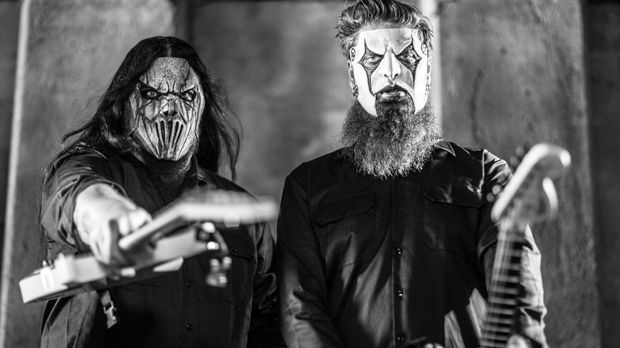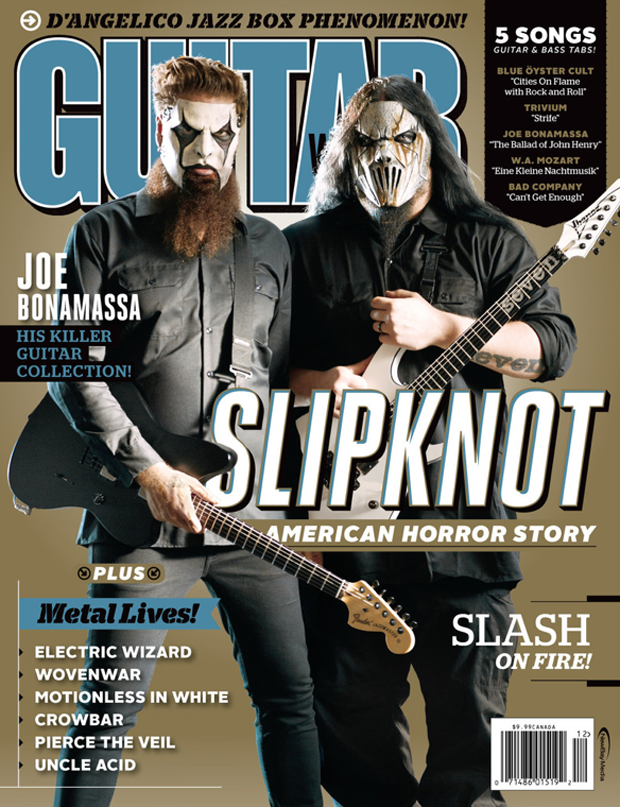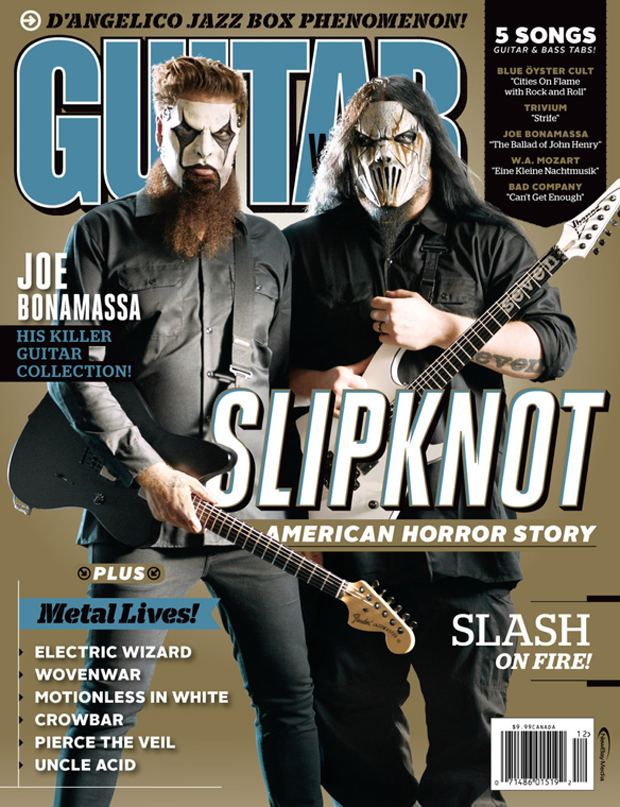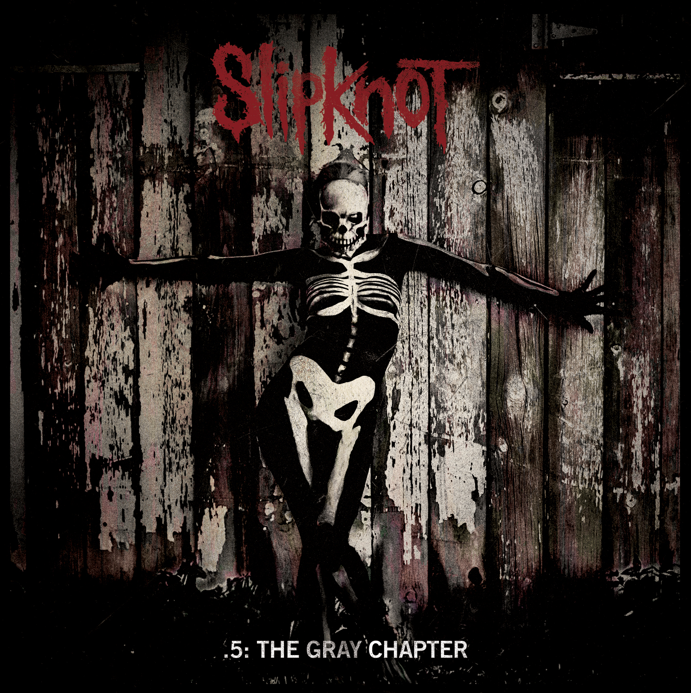Slipknot's Jim Root and Mick Thomson Talk Brutal New Album, '.5: The Gray Chapter'

This is an excerpt from the December 2014 issue of Guitar World. For the rest of this Slipknot story, plus features on Slash, Joe Bonamassa, Lenny Kravitz, Paul Gilbert, Motionless In White, Electric Wizard and more, including lessons, tabs and reviews of new gear from D'Angelico, Washburn, Boss, Morley, Lace Music and Carr Amps, check out the December 2014 issue at the Guitar World Online Store.
Shades of Gray: Between the death and departure of various band members, Slipknot have had a rough few years. With .5: The Gray Chapter, they channel the energy of deceased bassist Paul Gray and return with a brutal but multifaceted album.
“The future of Slipknot is always in doubt,” guitarist Jim Root says. “I always prepare for each album as if it’s gonna be the last.”
It’s a minor miracle that Slipknot have lasted as long as they have. They have nine members in their lineup, each of whom lives up to the band’s aggro metal image in one way or another, and thereby contributes to the potential for volatility.
Yet, they have endured since the group formed in Des Moines, Iowa, 19 years ago, becoming one of the heaviest and scariest bands in a genre crowded with heavy, scary acts. Some 13 years have elapsed since the band’s self-titled 2001 debut album placed them at the forefront of the then-burgeoning nu-metal scene.
“With all the different guys in the band and all the different ideas of what’s what, it’s hard to get everybody on the same page sometimes,” Root says. “We are a very tight brotherhood, but we never know what we’re going to do.”
However, nothing in Slipknot’s turbulent history has been as daunting as the death of their longtime bass player, Paul Gray, from a morphine overdose in 2010. The tragedy was compounded by the recent departure—somewhat acrimonious, apparently—of longtime drummer Joey Jordison. Because both Gray and Jordison were key songwriters for the band, Slipknot’s future has hung in the balance these past few years.
But Mick Thomson, Gray’s coguitarist, says he never really considered packing it in.
“Any devastating moment throws you into shock,” he says. “I was just hoping that no one in the band was going to get caught up in the raw emotion of the moment and make any kind of grand statement, like, ‘I will not go on without Paul.’ You say something in the heat of emotion, and sometimes later when you settle down, you think, Maybe I should take that back. Once you can think straight again, what do you do? Obviously, you gotta get on with your life. We all grieve differently. I mean, we still are grieving, every time we think about it. It’s not something you get over. You just find a way to deal with it.”
With Gray and Jordison out of the picture, the bulk of songwriting duties fell to Root on Slipknot’s new album
.5: The Gray Chapter
. The title pays homage to the deceased bassist, and the music remains true to Slipknot’s disturbing legacy.
Somber, sound-collage intros—generally assembled by Slipknot’s turntablist Sid Wilson, sampling maven Craig Jones and provocateur-in-chief Shawn “Clown” Crahan—lull the listener into a false sense of security. Then all hell breaks loose in a cacophony of car-bomb percussion as Root and Thomson’s down-tuned guitars chug and grind like some diabolic machine and lead singer Corey Taylor does his level best to projectile-vomit his tonsils out over his front teeth.
“Once we get in the studio, it sounds like us,” Thomson says of
The Gray Chapter
. “Some of it is very classic us. Some of it is slightly more experimental us.”
“We’re still evolving as a band,” Root adds. “I think that’s really important for a band to do, especially after being around for so many years. Paul, before he passed away, really wanted the band to experiment a lot more, musically, with the direction of where we’re going. We’d done Slipknot. We’d done Iowa. I think the closest thing we’ve done to a record that Paul was very excited about was probably The Subliminal Verses. It’s very diverse. It had a little bit of everything in it. And we’re still trying to find our way. For me, and for Paul’s legacy, it’s important that we continue to evolve.”
In Gray’s absence, Root and Thomson handled the majority of bass duties on the new album, although the band did some early work with Slipknot’s touring bassist Donnie Steele. “Donnie’s a great guy,” Root says. “We brought him in to help us out in the studio for a while. But it wasn’t really jivin’. He wanted to go home and get married and do all that stuff. It’s just better off for us to kinda move on from Donnie.”
The identity of the drummer on
The Gray Chapter
, as well as that of the bassist who will take Gray’s place once Slipknot hit the road, was still a closely guarded secret at press time.
“We’re not saying who the new drummer is,” Root confirms. “Even if people find out beyond a shadow of a doubt who the new drummer is, I think we’re always going to deny who it is. He might not last. He might tour with us a year and figure out we’re all insane and he can’t handle being around us. Or we might shut him out. Who knows? For Slipknot, I’d say drumming is only 50 or 60 percent of the job. The rest of it is who you are and what your personality is. Will you clash with guys like me, Mick, Clown, Corey, Craig and Chris? We all have these strong alpha-male personalities.”
Photo: Sean Murphy
This is an excerpt from the December 2014 issue of Guitar World. For the rest of this Slipknot story, plus features on Slash, Joe Bonamassa, Lenny Kravitz, Paul Gilbert, Motionless In White, Electric Wizard and more, including lessons, tabs and reviews of new gear from D'Angelico, Washburn, Boss, Morley, Lace Music and Carr Amps, check out the December 2014 issue at the Guitar World Online Store.



Get The Pick Newsletter
All the latest guitar news, interviews, lessons, reviews, deals and more, direct to your inbox!
In a career that spans five decades, Alan di Perna has written for pretty much every magazine in the world with the word “guitar” in its title, as well as other prestigious outlets such as Rolling Stone, Billboard, Creem, Player, Classic Rock, Musician, Future Music, Keyboard, grammy.com and reverb.com. He is author of Guitar Masters: Intimate Portraits, Green Day: The Ultimate Unauthorized History and co-author of Play It Loud: An Epic History of the Sound Style and Revolution of the Electric Guitar. The latter became the inspiration for the Metropolitan Museum of Art/Rock and Roll Hall of Fame exhibition “Play It Loud: Instruments of Rock and Roll.” As a professional guitarist/keyboardist/multi-instrumentalist, Alan has worked with recording artists Brianna Lea Pruett, Fawn Wood, Brenda McMorrow, Sat Kartar and Shox Lumania.

